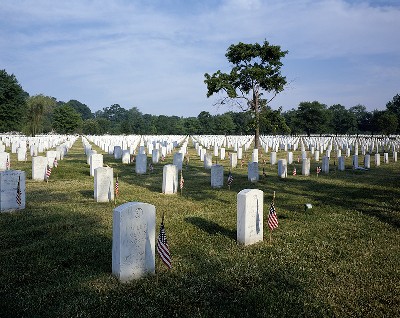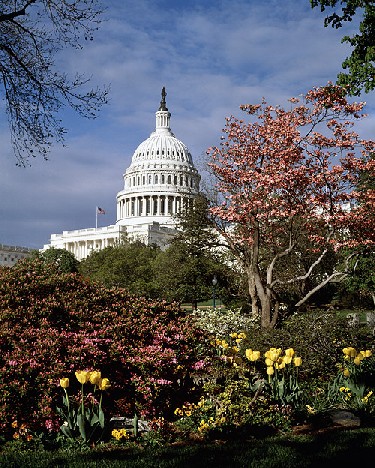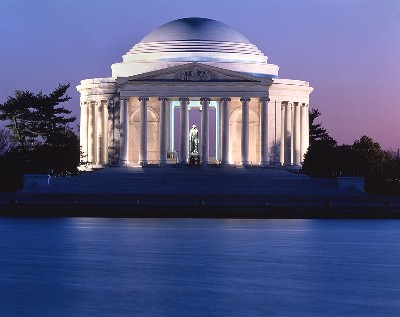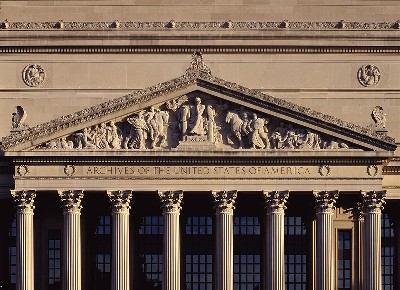Washington, D.C. Memorials and Landmarks

Arlington National Cemetery

Arlington National Cemetery occupies 612 acres in Virginia on the Potomac River, directly opposite Washington. In 1864, Arlington became a military cemetery. More than 240,000 service members and their dependents are buried there. In 1921, an Unknown American Soldier of World War I was buried in the cemetery. The monument at the Tomb of the Unknown Soldier was opened to the public in 1932. Two additional Unknowns, one from World War II and one from the Korean War, were buried there on May 30, 1958. The Unknown Serviceman of Vietnam was buried on May 28, 1984. In June 1998 he was identified as First Lt. Michael Blassie, an Air Force pilot from St. Louis. The inscription carved on the Tomb of the Unknowns reads: HERE RESTS IN HONORED GLORY AN AMERICAN SOLDIER KNOWN BUT TO GOD
Capitol Building

This is where Congress meets and conducts business. It is located on the east end of the Mall. Construction of the building started in 1792, and its design was modified several times, until it was finished in 1865. The Capitol's most recognizable feature is the 180-foot-high cast iron dome of the Great Rotunda. In addition to its historical association, the Capitol Building is also a vast artistic treasure house. The works of such famous artists as Gilbert Stuart, Rembrandt Peale and John Trumbull are displayed on the walls. The Great Rotunda is decorated with a massive fresco by Constantino Brumidi. A monorail subway joins the House and Senate wings of the Capitol with the Congressional office buildings.
Jefferson Memorial

In 1934, Congress authorized the construction of a memorial to honor Thomas Jefferson, the third President of the United States. He is considered the political philosopher of the American Revolution. He also drafted the Declaration of Independence. Architect John Russell Pope, who designed the memorial, used some of Jefferson's own architectural preferences in his design. The memorial, like Jefferson's home in Monticello, is based on the Roman Pantheon. Construction of the circular marble building was finished in 1943. It is located near the Potomac River and overlooks the Tidal Basin, which is surrounded by Japanese flowering cherry trees.
Lincoln Memorial

Construction of this memorial to the 16th President of the United States started in 1914 and was completed in 1922. It is located on the west end of the Mall. Architect Henry Bacon modeled the marble, granite and limestone building after the Greek Parthenon. The inside of the memorial is divided into three chambers: central, north and south. A white marble statue of President Lincoln sits in the central chamber. The Gettysburg Address, which Lincoln gave on November 19, 1863, at Gettysburg, Pennsylvania , is in the south chamber, and his second inaugural speech is in the north chamber. The 36 Doric columns on the outside of the memorial represent the number of states in the Union at the time of Lincoln's death in 1865.
National Archives

The National Archives is the official library where the records of the three branches of the U.S. government are kept and preserved. The Declaration of Independence, the Constitution and the Bill of Rights are on display here. A collection of pictures taken during the Civil War by the famous photographer Matthew Brady are also on display. The building is located on Constitution Avenue in Washington, D.C. The agency was created in 1934 and the building was completed in 1935.
National Mall

No, this isn't the official shopping center of the United States. It is a 146-acre stretch of lawn that extends from the Potomac River to the Capitol Building. The area hosts political rallies, festivals and other events. Many of Washington's famous memorials and the Smithsonian's museums and galleries surround the Mall. The National Park Service maintains the grounds.
Smithsonian Institution

A rich English researcher, James Smithson, left all his money to create a museum in Washington, D.C. to “the increase and diffusion of knowledge.” And he never even visited the United States! He also left his scientific library and his collection of minerals for the new museum. The Smithsonian is not just one building. It is a network of museums and art galleries, research projects and special performances. It includes 14 museums. Some of them are the National Air and Space Museum, the Museum of Natural History and the National Portrait Gallery.
U.S. Holocaust Memorial Museum

The Holocaust Museum opened in 1993 and is located near the Mall, which is where many of Washington's museums and memorials are located. The museum is America's national institution for the documentation, study and interpretation of Holocaust history. The memorial houses the largest collection of material about the murder of more than six million Jews by Nazi Germany between 1933 and 1945. It cost more than $168 million to build the museum. Because many of the exhibits are graphic and upsetting, children under age 12 should probably wait until they are older to visit the museum.
Vietnam Veteran's Memorial

This memorial to the men and women who died in the Vietnam War also serves to remind the people who didn't agree with the United States' participation in the unpopular war that thousands of Americans lost their lives in the jungles of Vietnam. Congress authorized the memorial in 1980, and more than 1,400 people submitted design ideas for the memorial. A 21-year-old Yale University student, Maya Lin, won the contest. The V-shaped memorial is made of black granite. The names of more than 58,000 veterans who lost their lives in the war are etched in the wall.
Washington Monument

Construction of this magnificent Washington, D.C., monument took nearly a century of planning, building and controversy. The first plans, which were dropped, called for a large equestrian statue of George Washington. After Washington's death in 1797, a memorial was discussed, only to be delayed again. Finally, in 1848, work started on the monument that stands today. After more fits and starts, the monument was finished in 1884 and opened to the public in 1888. The tapered shaft, or obelisk, is made of stone and is covered with white marble. The monument stands just over 555 feet. Memorial stones from the 50 States, foreign countries and organizations line the inside walls. The top of the monument, which you can get to only by elevator, provides a panoramic view of the city.
White House

The 132-room White House is the official residence of the president. It is located at 1600 Pennsylvania Avenue. President George Washington chose the site in 1792 and supervised construction. The architect was James Hoban. The mansion was not finished until 1800, so Washington is the only president who never lived in the White House. The British burned the building in 1814, during the War of 1812. The rooms for public functions are on the first floor. The second and third floors are used as the residence of the president and first family. The most celebrated public room is the East Room, where formal receptions take place. Other public rooms are the Red Room, the Green Room and the Blue Room. The State Dining Room is used for formal dinners.
World War II Memorial

The National World War II Memorial commemorates the 16 million Americans who served in the armed forces during the second World War, the more than 400,000 soldiers who died in it, and the millions more who supported the war effort from home. Designed by Friedrich St. Florian, it is located in the National Mall, between the Washington Monument and the Lincoln Memorial. It is the size of a football field, and contains arches, pillars, a wall of stars, fountains, a pool, and many inscriptions. It was authorized in 1993, and dedicated in 2004.
